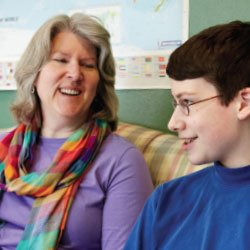Bright Ideas: Flex the Homeschool Day to Fit Kids' Passions
If you think homeschooling looks like a mother and her children peacefully doing their lessons around the kitchen table all day, Jill Davis Bell '87 would like to disabuse you of that notion.
When she began homeschooling, she says it looked a bit more like “school at home”: math in the morning, reading in the afternoon. But as she grew more confident, she discovered that a more flexible schedule fit better with the way her two sons learn.
She and her younger son, Peter, will do math lessons together in the morning. Then, it might be history all day. Or if it's sunny, they might get together with other homeschooling friends for a biology lesson at the park.
Meanwhile, her older son, Andrew, might be prepping for his next homeschool speech and debate tournament. The family recently traveled to Southern California when Andrew participated in the Concordia Challenge tournament. The freedom and flexibility of homeschooling, she says, has been “an opportunity for him to go deep in his passions.”

![]() View more photos
View more photos
Jill Bell says she's found the responsibility of homeschooling her two sons to be a tremendous gift. "I so enjoy being a part of their learning,” she says.
Bell also enjoys supporting parents who want to homeschool but may be lacking in confidence. She recently completed a term on the board of the Washington Homeschool Organization, and has sought out opportunities to mentor and encourage parents in person and through online forums. “It's a ministry,” she says.
Part of the freedom — and challenge — for homeschooling parents is navigating the maze of all the learning resources available. As online and distance learning explode worldwide, so do homeschooling options.
“I know a lot of homeschoolers who are taking AP classes online, who are doing distance learning,” Bell says. “That's a huge way the future is going.”
Online learning may also be making homeschooling accessible to families who might not previously have considered it as an option.
“One of the things that technology is doing is really blurring the lines between homeschooling and other forms of schooling,” says Robert Kunzman, a homeschooling researcher at the Indiana University School of Education. In some cases, students can independently take courses at a public, private, or charter school online, regardless of parental involvement. But, he says, “The
common thread that ties together most homeschoolers is the belief that parents have the right and responsibility to shape the education of their children.”
That responsibility certainly comes with challenges. For instance, Bell advises parents who would homeschool for high school, “If you think your child wants college — you need to craft their coursework accordingly — if it's even a remote possibility. Otherwise you're doing your child a disservice.” But, she adds, “It's more accessible than people think.”
Bell would know. Her older son, Andrew, has been accepted and plans to enroll at Seattle Pacific in Autumn 2012. He wants to study economics, and is currently learning calculus at his own pace through a self-guided CD-and-DVD-based curriculum.
“You find what motivates your kids, and you use that to continue to support them,” she says.
Create 180-Degree Change With Tiny Steps
Harness Technology That Gives Kids a Voice
Advocate for Students in and out of School
